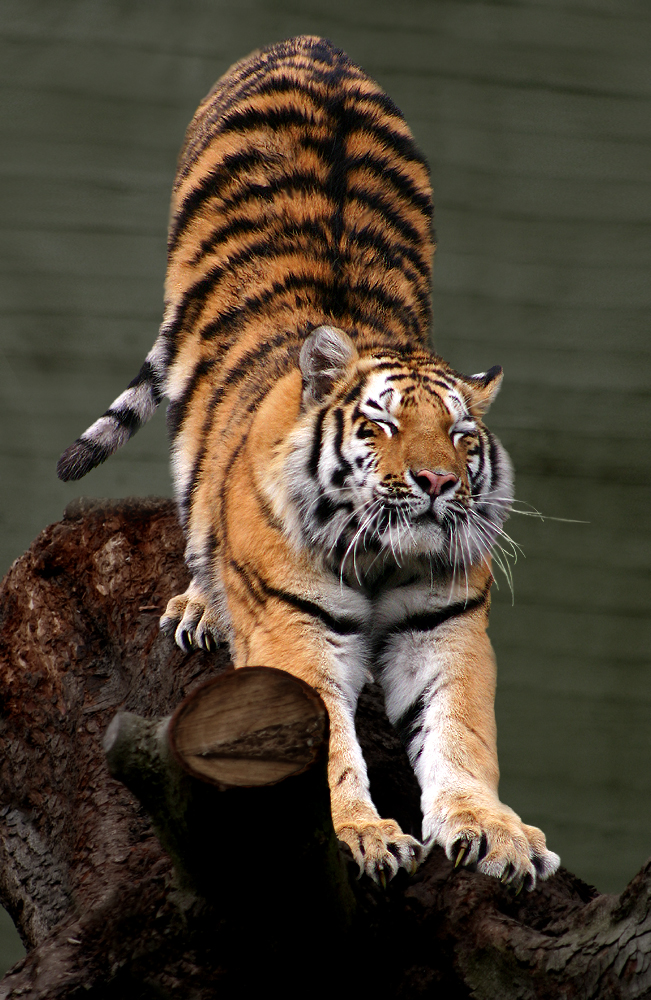Siberian Tiger / Amur Tiger (Panthera tigris altaica) - Wiki Amur Tiger
From Wikipedia, the free encyclopedia
[Photo] A stretching tiger. Siberian tiger (Panthera tigris altaica), Aalborg Zoo, Denmark. Date: 21. march 2004. Photo Credit: Malene Thyssen, www.mtfoto.dk/malene/
The Amur Tiger (Panthera tigris altaica) is a rare subspecies of tiger (P. tigris). Also known as the Siberian, Korean, Manchurian, or North China Tiger, it is the largest natural animal in the feline family Felidae.
The Amur Tiger is critically endangered. In the early 1900s, it lived throughout the Korean Peninsula, northeastern Mongolia, southeastern Russia, and northeastern China. Today, it has virtually disappeared from South Korea and is largely confined to a very small part of Russia's southern Far East (the Amur-Ussuri region of Primorye and Khabarovsk, a location where it and the Amur Leopard are now being actively protected). There are very few tigers in Manchuria (northeastern China) and fewer still in North Korea. Captive breeding and conservation programs are currently active.
The tiger population in the Sikhote-Alin was 250 in 1992, increasing to 350 as of 2004, despite significant losses of cubs due to car accidents on the single road that crosses their territory. Illegal poaching has been brought under control thanks to frequent road inspections. It is rumoured that there are still around 20 of these tigers in the Mount Changbai area of China.
As the total population of these tigers fell to 150 in the wild, many subpopulations are possibly not genetically viable, subject to potentially catastrophic inbreeding. However, Russian conservation efforts have led to a revival of the subspecies, and the number of individuals in the Primorsky region of Russia has risen from 450 to 500 in the past decade, indicating positive growth.
An Amur Tiger named Hodori was chosen to represent the 1988 Summer Olympics held in Seoul, South Korea.
Physical description
The male Amur Tiger can weigh as much as 318 kilograms (700 lb), although in past years, scientists believed that these cats could weigh up to 350 kilograms (800 lb), a supposition based largely on the estimates of hunters. On average, a tigress weighs about 160 kilograms (352 lb), and a male weighs about 225 kilograms (496 lb). At these sizes, the Amur Tiger is the largest natural creature of the cat family, though not as large as the liger, a panthera hybrid generally only found in captivity. The largest captive Amur tiger was 3.7 metres (12 ft) long and weighed over 423 kilograms (932 lb), compared to the largest captive African lion that weighed 366 kilograms (806 lb).
Apart from its size, the Amur Tiger is differentiated from other tiger subspecies by its paler fur, dark brown (rather than black) stripes and diverse diet (see below).
Diet
Like all other cats, the Amur Tiger is a carnivorous predator; an adept hunter, it preys primarily on wild boar, roe deer, sika deer and goral, but will also take smaller prey like lagomorphs (hares, rabbits, and pikas) and fish, including salmon. Unlike the Bengal Tiger, the Amur Tiger rarely attacks humans. It has sometimes even been known to kill and eat Asiatic black bears and even brown bears. Since it is estimated that 85% of an Amur Tiger's diet is composed of red deer and wild boar, protecting these and other prey animals from illegal hunting may be just as important to the tiger's survival as preventing direct killing of the big cats.
In captivity
The captive population of Amur Tiger comprises several hundred specimens. A majority of these tigers are found in Europe and North America, but there are also a few specimens living in Asian zoos. The Amur Tiger is bred within the Species Survival Plan (SSP), a project based on 83 wild caught tigers. According to most experts, this population is large enough to stay stable and genetically healthy. Today, approximately 160 Amur Tigers participate in the SSP, which makes it the most extensively bred tiger subspecies within the programme. There are currently no more than around 255 tigers in the tiger SSP from three different subspecies. Developed in 1982, the Species Survival Plan for the Amur tiger is the longest running program for a tiger subspecies. It has been very fortunate and productive, and the breeding program for the Amur tiger has actually been used as a good example when new programs have been designed to save other animal species from extinction.
The Amur Tiger is not very difficult to breed in captivity, but the possibility to release captive bred specimens into the wild is small. Conservation efforts that secure the wild population are therefore still of imperative importance. If a captive bred Amur Tiger were to be released into the wild, it would lack the necessary hunting skills and starve to death. Captive bred tigers can also approach humans and villages since they have learned to associate humans with feeding and lack the natural shyness of the wild tigers. In a worst-case scenario, the starving tigers could even become man-eaters. Since tigers must be taught how to hunt by their mothers when they are still cubs, a program that aimed to release captive bred Amur Tigers into the wild would face great difficulties.
The Amur Tiger sometimes cross-breeds with the Bengal Tiger. A white Amur Tiger is usually the result of such cross-breeding, and it is unclear whether a pure white Amur Tiger exists.
http://en.wikipedia.org/wiki/Amur_Tiger
| The text in this page is based on the copyrighted Wikipedia article shown in above URL. It is used under the GNU Free Documentation License. You may redistribute it, verbatim or modified, providing that you comply with the terms of the GFDL. |
